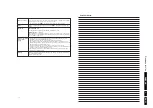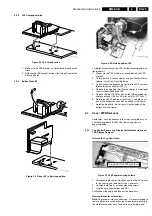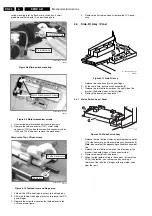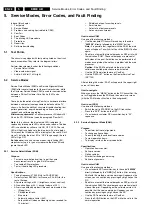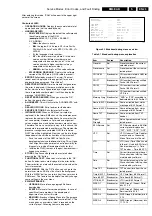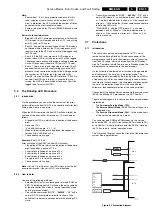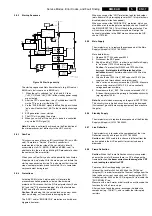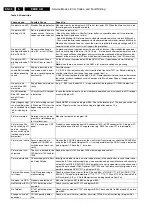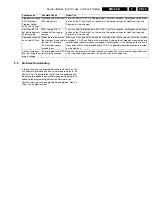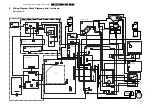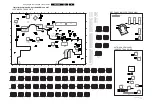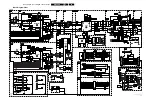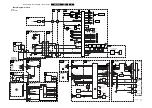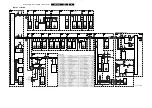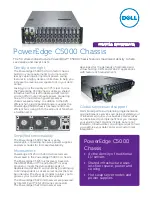
Service Modes, Error Codes, and Fault Finding
5.
Note:
•
Error codes 1, 6, or 18 are protection codes and in this
case, supplies of some circuits will be switched “OFF”.
Also, in protection, the LED will blink the number of times
equivalent to the most recent error code.
•
Some errors are only for TDL-sets (EM6E AB) or sets with
hard disk.
Extra info for certain errors:
•
Error 91: If the TDL microprocessor gets an error from the
LCD display, this will be reported to the OTC, and will log
error 91 (only for TDL sets).
•
Error 92: If one of the micro-switches of the LCD display is
not closed within a timeout, the TDL microprocessor will
report an error to the OTC, and error 92 will be logged (only
for TDL sets).
•
Error 93: If the 3V3 is not present in DVD mode, or is
present when DVD is in stand-by, error 93 will be logged.
The presence or absence of the supply voltage is detected
via the I/O expander (schematic T3) (only for TDL sets).
•
Error 97: There are 2 inputs to generate an error: The IO
expander that checks the supply voltages and the HDD
processor witch controls the hard disk itself. Both generate
the same error: HDD error (only for sets with HDD).
•
Error 98: via a control line of the HDD interface IC (7022) is
sensed if the HDD fan is turning. In case the fan is not
turning, the HDD will be switched off and error 98 will be
logged (only for sets with HDD).
5.6
The Blinking LED Procedure
5.6.1
Introduction
Via this procedure, you can make the contents of the error
buffer visible via the front LED. This is especially useful for fault
finding, when there is no picture.
When the SDM is entered, the front LED will show (blink) the
contents of the error-buffer. Error-codes > 10 are shown as
follows:
–
A long blink of 750 ms (which is an indication of the decimal
digit),
–
A pause of 1.5 s,
–
“n” short blinks (where “n” = 1 - 9),
–
When all the error-codes are displayed, the sequence
finishes with a LED blink of 3 s,
–
The sequence starts again.
Example: Error 12 9 6 0 0.
After activation of the SDM, the front LED will show:
–
1 long blink of 750 ms (which is an indication of the decimal
digit) followed by a pause of 1.5 s,
–
2 short blinks followed by a pause of 3 s,
–
9 short blinks followed by a pause of 3 s,
–
6 short blinks followed by a pause of 3 s,
–
1 long blink of 3 s to finish the sequence,
–
The sequence starts again.
Note: If errors 1, 6 or 18 occur, the LED always gives the last
occurred error even if the set is NOT in service mode.
5.6.2
How to Enter
Use one of the following methods:
•
Enter the SDM (only via soldering pads marked “SDM” on
SSP). The blinking front LED will show the entire contents
of the error buffer (this works in “normal operation” mode
and in “protection” mode).
•
Transmit the commands “MUTE” - “062500” - “OK” with a
normal RC. The complete error buffer is shown. Take
notice that it takes some seconds before the blinking LED
starts.
•
Transmit the commands “MUTE” - “06250x” - “OK” with a
normal RC (where “x” is a number between 1 and 5). When
x= 1 the last detected error is shown, x= 2 the second last
error, etc.... Take notice that it takes some seconds before
the blinking LED starts.
•
“DIAGNOSE X” with the DST (where “x” is a number
between 1 and 5). When x= 1 the last detected error is
shown, x= 2 the second last error, etc.... When x = 0 all
errors are shown.
5.7
Protections
5.7.1
Introduction
This chassis has only one microprocessor (OTC), which
remains active during Standby. This because power of the
microprocessor and the attached memory chip set is coming
from the 3V3 supply, which is derived from the 5V Standby-
circuitry. Therefore, in both Power-on as in Standby mode, the
microprocessor is connected to this power supply.
If a fault situation is detected, an error code will be generated
and if necessary, the set is put in protection mode. The
protection mode is indicated by the blinking of the front LED at
a frequency of 3 Hz (or by a coded blinking in special cases).
In some error cases however, the microprocessor does not put
the set in the protection mode (this is the case with the -
hardware - loudspeaker protection of the audio amplifier).
The content of the error buffer can be read via the service menu
(SAM), the blinking LED procedure or via DST/ComPair.
To get a quick diagnosis, this chassis has three service-modes
implemented:
•
The Customer Service Mode (CSM).
•
The Service Default Mode (SDM). Start-up of the set in a
predefined way.
•
The Service Alignment Mode (SAM). In this mode, items
of the set can be adjusted via a menu.
You can enter both SDM and SAM modes via the “service
pads” on the SSP, via an RC-transmitter (DST or standard RC),
or via ComPair. It is not possible to enter the SAM in “standby”;
the TV has to be in “normal operation” mode.
The “Protection Diagram” shows the structure of the protection
system. See diagram below.
Figure 5-3 Protection diagram
XPR (43)
7301
7001
FLS (5)
HFB-XRAY-PROT
HOP
+8V SENSE (105)
+5V SENSE (106)
OTC
EHT-info
HFB
+5V_CON
+8V_CON
Flash detect
I2C
I2C PROTECTIONS
HIP
HOP
PICNIC
TUNER
NVM
DNR
MSP
TOPIC
I2C
I2C
PICNIC 3V3
FBX
PROTECTION
CL 16532044_024.eps
090501



